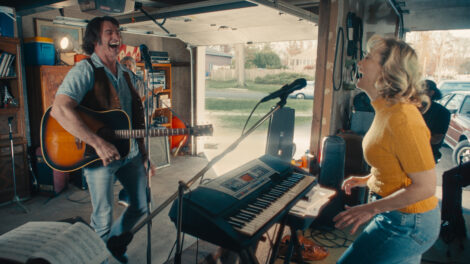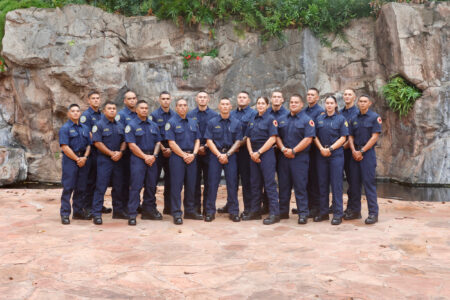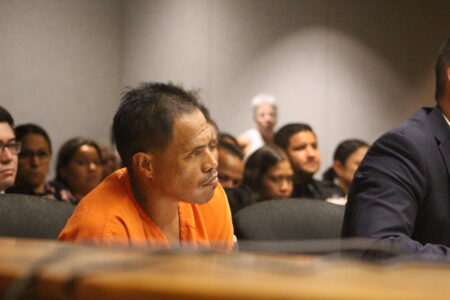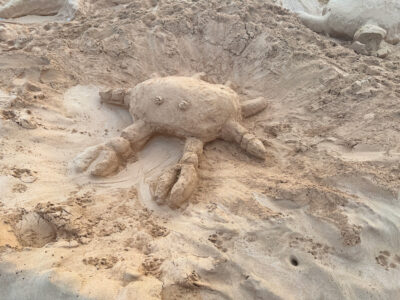Field producer of Emmy-winning ‘Maui’s Deadly Firestorm’ documentary hopes to continue community conversation
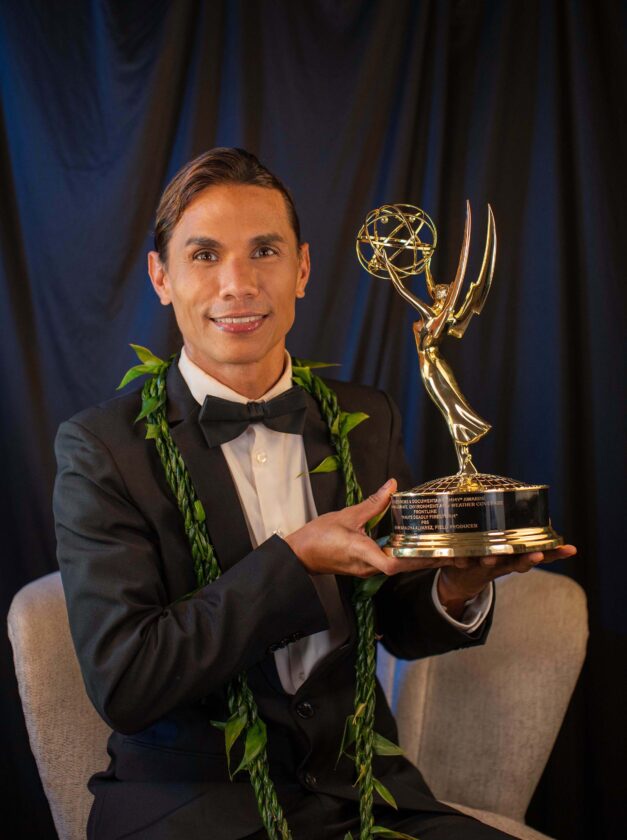
Keoni Alvarez holds up the Emmy Award that he won for his work on the PBS Frontline documentary “Maui’s Deadly Firestorm.” Courtesy photo
More than two years after the 2023 Lahaina wildfire, the field producer of an Emmy-winning documentary is wondering if the time is right for a screening in West Maui.
The PBS Frontline documentary, “Maui’s Deadly Firestorm,” takes a comprehensive look at the events leading up to the deadly wildfires on Aug. 8, 2023, and the team behind it was honored for their work with the News Emmy Award for Outstanding Climate, Environment and Weather Coverage during a June ceremony in New York City.
For Keoni Alvarez, who worked on the project as a field producer, winning an Emmy was an honor — but more important, he said, is how the film can honor the victims, help the community heal and prevent another tragedy.
“Never in American history have we seen a wildfire take the lives of over a hundred people. It was catastrophic and heartbreaking that it ever happened,” Alvarez said. “This film is meant to raise awareness about the profound impact on our community — and also to spark conversations about the future, so that negligent practices are not ignored and real, proactive solutions can be put in place.”
The hourlong film details the circumstances leading up to the 2023 Maui wildfires, including how the extreme weather conditions, lack of preparedness and critical failures in the emergency evacuation all came together to spawn the deadliest U.S. wildfire in over a century.
For “Maui’s Deadly Firestorm,” the team behind the film spoke to many different people and pulled a wealth of information from public documents and after-action reports.
The film includes cellphone videos and audio from emergency 911 calls, as well as interviews with Hawaii Gov. Josh Green, Maui County Mayor Richard Bissen and other public officials.
The most heartbreaking parts of the documentary, however, likely come when the team sat down with survivors who recalled how the deadly fire destroyed more than 2,000 structures in their beloved town and sent them fleeing into the ocean to escape the flames.
Using a fact-based approach, the film explores longstanding issues with land management, city planning, water diversions and invasive vegetation. In the aftermath, the team goes on to detail ongoing tensions in the community as people face overwhelming challenges with housing, emotional trauma and rebuilding efforts.
“This was a totally complex documentary,” Alvarez said. “Imagine putting a story together and trying to tell the story and get the history and being unbiased, and just trying to share this story from the eyes of the community.”
Alvarez added that every line in the documentary was vigorously fact-checked for accuracy, and in the end, he thinks everyone who worked on the project did an amazing job.
“Still today, it’s a documentary of research,” he said. “It’s a timeless documentary that marks history. So it’s not just a documentary, but people can go back if they want to do research and more investigation; this is the film to start from to see what really went on.”
Reflecting on the work
Winning an Emmy for work on such a tragic event has brought mixed emotions for Alvarez, who said he feels both proud and humbled.
“This project was never about accolades, even though winning an Emmy was a huge honor,” he said. “It has always been about documenting a tragedy in a way that preserves truth, honors the lives lost, and helps future generations understand the impact.”
He said the principle of “aloha” guided the work and that the team sought to honor the memory of Lahaina while acknowledging the loss of land and property.
“As Hawaiians, we follow the values of our ancestors: respect, love, kindness, generosity and honesty, to name a few,” he said. “These key values have been our guide, and they shaped how our film team told this important and historic story.”
Alvarez said the film was created to support the families, not to hurt them.
“It documents the strength of the Lahaina community — their willingness to share their stories and be vulnerable,” he said. “The victims and survivors who spoke with us were never rehearsed. Their words came directly from the puʻuwai, the heart — and as we say in Hawaiian, from deep within the naʻau, the pit of the stomach. These were their deepest, most honest feelings and expressions of self. Our responsibility as filmmakers was to honor that truth with respect and care.”
A local perspective
Alvarez is a producer, director and editor from Hawaii Island who came onboard with the “Firestorm” team after directing another documentary, “Kapu: Sacred Hawaiian Burials,” that was aired by PBS Hawaii.
Because of his experience working previously on Maui and the level of care he had to show working with such a sensitive topic for the “Kapu” film, Alvarez said he already had existing connections with families in Lahaina and he was in the right mindset to help the documentary team tell the story well.
“PBS Frontline is coming from Washington, D.C., and New York, and so there’s a different way of how to do things and film, so I was just making sure that, at least locally, they approached it with respect,” Alvarez said.
He explained that the team included just a handful of people working in the field, and they came to Maui multiple times in the year after the fire, which was an extremely sensitive time for many people in the community.
“They had understanding for our people,” he said of the filmmakers. “It was just really encouraging to work with the team. They were very sensitive with the interviews that we had and treated everybody with aloha and respect.”
Developing the story
As they were working to gather interviews and information for the documentary, the story kept evolving with new developments such as Lahaina Strong occupying Kaanapali Beach in a protest for housing or governmental agencies issuing post-fire assessment reports.
“That’s how documentaries work,” Alvarez said. “Documentaries, it’s nothing planned out. You’re filming as you go — putting story as you go — because you don’t know how the story is going to change. You never know if it’s going to be a victorious ending, or if it’s going to go a whole completely different direction.”
While the outcome remained uncertain, Alvarez said there was never any doubt about the quality of the Frontline team, adding that it was a joy to work with them both in the field and with the people in their offices in New York and Washington, D.C.
West Maui screening?
Alvarez said he believes the time might be right for a screening in Lahaina or West Maui.
Last month, the film was shown during the Akaku Upstairs series, and Alvarez said the screening brought some people to tears but was very well received.
During the screening, the entire film was played after brief introductions for the featured speakers who included Alvarez along with writer, producer and director Xinyan Yu, who appeared via Zoom, in addition to Lahaina cultural practitioner and educator UʻI Kahue-Cabanting. Akakū’s education and production director Kat Tracy served as the moderator. A video from the Akaku Upstairs screening is available on Akaku’s website.
The event was through RSVP and a small venue. Now, Alvarez said he thinks it would be good to hold a similar event in Lahaina.
“Ideally, West Maui would be the most meaningful place for a screening,” he said. “That is where the heart of the story lives, and it’s important that survivors and families have access. At the same time, we are open to other parts of Maui if it means reaching more people in a safe and respectful way.”


